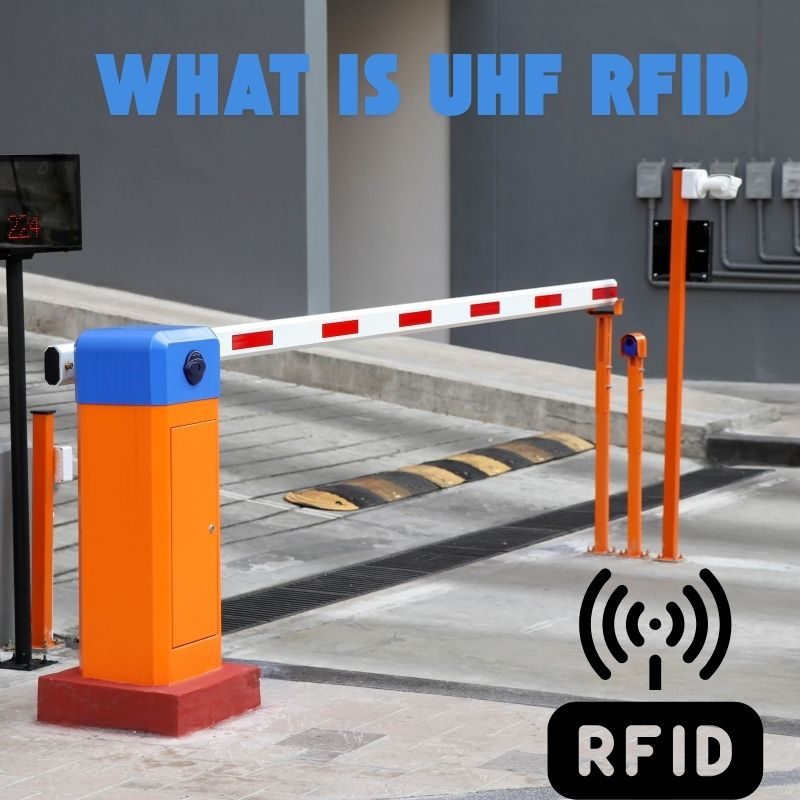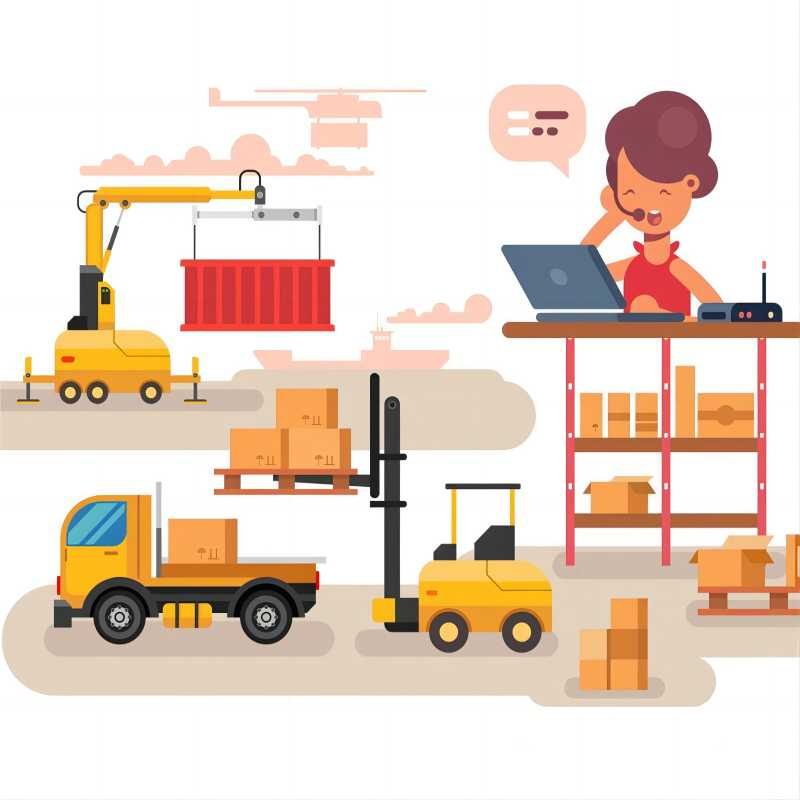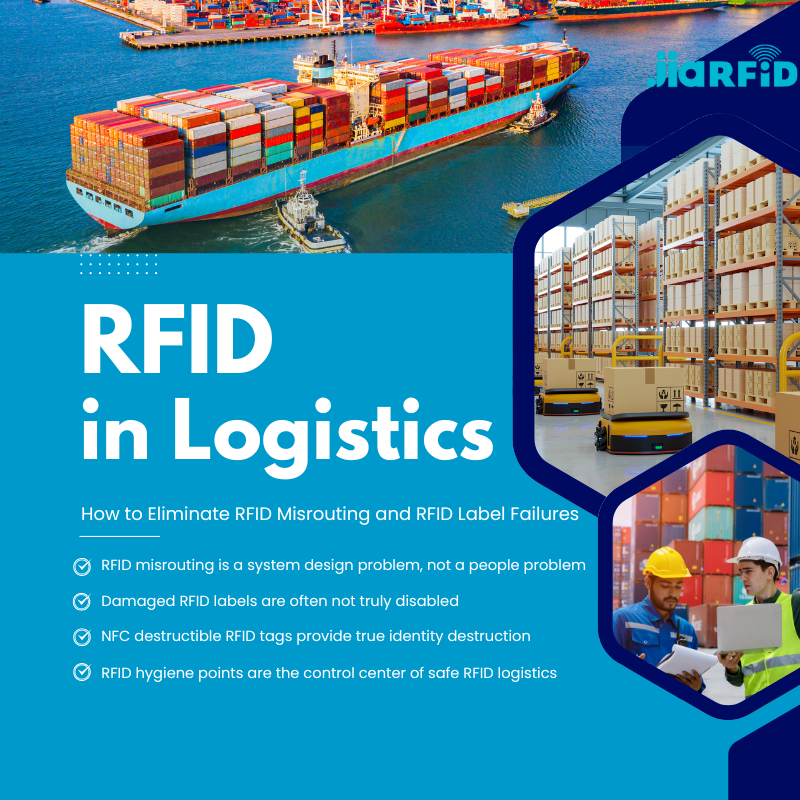
UHF RFID Nedir?
İçindekiler
giriiş
UHF RFID (Ultra Yüksek Frekanslı Radyo Frekansı Tanımlama) çeşitli sektörlerde hızla yaygınlaşan son teknoloji bir tanımlama teknolojisidir. Perakende ve lojistikten sağlık ve tarıma kadar, hızlı ve temassız veri alışverişi sağlama özelliği, işletmelerin çalışma şeklini dönüştürmektedir.
RFID'yi ilk kez keşfediyor ya da bilgilerinizi derinleştirmek istiyorsanız, bu kılavuz size şu konularda yol gösterecektir: UHF RFID nasıl çalıştığı, uygulamaları ve neden 2025 yılında bilinmesi gereken bir teknoloji olduğu.

UHF RFID Nedir?
UHF RFID, Ultra Yüksek Frekanslı Radyo Frekansı Tanımlama'nın kısaltmasıdır ve nesnelere takılan etiketleri tanımlamak ve izlemek için radyo dalgalarını kullanan bir kablosuz iletişim teknolojisidir. RFID teknolojisindeki üç ana frekans kategorisinden biridir; diğer ikisi Düşük Frekans (LF) ve Yüksek Frekans (HF)dır.
UHF genellikle 860 MHz ile 960 MHz aralığında çalışır ve aşağıdakilerle tanınır:
- Daha uzun okuma mesafeleri (12 metreye kadar veya daha fazla)
- Daha hızlı veri iletimi
- Toplu okuma özelliği
Daha basit bir ifadeyle, UHF RFID dijital bir “güçlendirilmiş barkod” gibidir — görüş hattı gerekmez ve yüzlerce ürün anında okunabilir.
UHF RFID Nasıl Çalışır?
UHF RFID'nin nasıl çalıştığını anlamak için, temel bileşenlerine bir göz atalım:
- RFID Etiketleri: Verileri depolayan bir mikroçip ve anten içerir.
- RFID Okuyucular: Radyo dalgaları yayar ve etiketlerden veri alır.
- Antenler: Etiketler ve okuyucular arasındaki sinyali güçlendirin.
- Ara yazılım/Yazılım: Toplanan verileri işler ve yönetir.
İki ana tür vardır UHF RFID etiketleri:
- Pasif UHF Etiketleri: Okuyucunun sinyalinden gelen enerjiye güvenin; daha ucuz ve yaygın olarak kullanılır.
- Aktif UHF Etiketleri: Pille çalışır; uzun menzilli ve gerçek zamanlı uygulamalar için uygundur.
Anahtar İşlevsellik:
- Okuyucu, UHF bandında bir sinyal yayar.
- Etiket enerji alır, çalışır ve verilerini geri gönderir.
- Okuyucu bu verileri toplar ve işlenmek üzere bir arka uç sistemine gönderir.
Sistem, yüksek hızlarda bile birden fazla etiketi aynı anda okuyabilir. Bu özellik, UHF RFID'yi konveyör bantları veya hızlı hareket eden envanter gibi dinamik ortamlar için ideal hale getirir.
UHF RFID Teknolojisinin Avantajları
UHF RFID neden bu kadar ilgi görüyor? Çünkü gerçek dünyadaki izleme ve otomasyon sorunlarını çözüyor. İşte öne çıkan avantajları:
- Uzun Okuma Aralığı: Engebeli ortamlarda bile 12 metreye kadar
- Toplu Okuma: Saniyeler içinde yüzlerce etiketi okuyun
- Uygun Maliyetli: Pasif etiketler, büyük ölçekli kullanım için uygun maliyetlidir.
- Gerçek Zamanlı Görünürlük: Envanter ve varlık hareketleri hakkında anlık güncellemeler
- Görüş Hattı Dışı: Barkodlarda olduğu gibi doğrudan tarama yapmaya gerek yoktur
- Ölçeklenebilirlik: Küçük işletmeler veya küresel tedarik zincirleri için uygundur
Kısacası, modern işletmelerin temel dayanakları olan verimlilik, doğruluk ve otomasyonu artırır.
UHF RFID'nin Yaygın Uygulamaları
UHF RFID, olağanüstü menzil, hız ve çok yönlülük sunan modern otomasyon ve izleme sistemlerinde temel bir teknoloji olarak ortaya çıkmıştır. Yüzlerce etiketi aynı anda ve uzun mesafelerden okuyabilme özelliği, onu çok çeşitli endüstrilerde paha biçilmez kılar.
Perakende
- Envanter kontrolü
- Hırsızlık önleme sistemleri
- Otomatik ödeme
- Gerçek zamanlı stok güncellemeleri
Lojistik ve Tedarik Zinciri
- Gönderi takibi
- Palet yönetimi
- Çapraz sevkiyat işlemleri
- Teslimat kanıtı
Üretme
- Devam eden iş (WIP) takibi
- Kalite kontrol
- Ekipman izleme
Sağlık hizmeti
- Hasta bileklikleri
- Ekipman takibi
- İlaç envanteri
Tarım
- Hayvancılık izleme
- Tarım ekipmanlarının takibi
- Akıllı sulama sistemleri
Kütüphaneler ve Eğitim
- Kitap takibi
- Laboratuvar varlık yönetimi
- Erişim kontrolü
Sektör ne olursa olsun, UHF RFID gerçek zamanlı görünürlük, verimlilik ve izlenebilirlik sunar.
UHF RFID ile HF ve LF RFID Arasındaki Temel Farklılıklar
| Özellik | LF (Düşük Frekans) | HF (Yüksek Frekans) | UHF (Ultra Yüksek Frekans) |
|---|---|---|---|
| Sıklık | 125-134 kHz | 13,56 MHz | 860-960 MHz |
| Okuma Aralığı | ~10 cm | ~1 m | 12 m'ye kadar |
| Veri Hızı | Yavaş | Ilıman | Hızlı |
| Maliyet | Düşük | Ilıman | Değişir |
| Kullanım Örnekleri | Hayvan takibi | Temassız ödemeler | Tedarik zinciri, perakende, lojistik |
UHF RFID, en uzun okuma menzili ve en hızlı performansı sunarak hızlı tempolu ortamlar ve yüksek hacimli izleme için idealdir.
UHF RFID Standartları ve Yönetmelikleri
Standartlar, uyumluluğu sağlamak için UHF RFID'nin küresel kullanımını düzenler:
- EPCglobal Gen2 / ISO 18000-6C: Pasif UHF RFID için endüstri standardı
- FCC (ABD): 902–928 MHz frekans aralığında çalışır
- ETSI (Avrupa): 865–868 MHz frekansında çalışır
- Diğer Bölgeler: Telekom düzenlemelerine göre biraz farklılık gösterebilir
UHF RFID'yi küresel olarak kullanırken bölgesel frekans düzenlemelerine uyum sağlamak çok önemlidir.
UHF RFID Etiket Türleri
Pasif UHF RFID Etiketleri
- En yaygın
- Maliyet etkin
- Perakende, lojistik vb. alanlarda kullanılır.
Aktif UHF RFID Etiketleri
- Pil ile çalışan
- Daha uzun menzil
- Yüksek değerli varlıkların takibinde kullanılır
Yarı Pasif (BAP) Etiketler
- Daha iyi performans için pil destekli
Etiket Form Faktörleri
- Kakma
- Etiketler
- Sert etiketler
- Metal veya zorlu ortamlar için dayanıklı etiketler
Ortamınıza, menzil gereksinimlerinize ve bütçenize göre etiket türünü seçin.
UHF RFID'nin Zorlukları ve Sınırlamaları
Diğer tüm teknolojiler gibi, UHF RFID de mükemmel değildir. Dikkat edilmesi gereken noktalar şunlardır:
- Metal ve Sıvı Girişimi: Sinyalleri engelleyebilir veya bozabilir
- Çevresel Faktörler: Aşırı sıcaklıklar performansı etkileyebilir
- Görüş Hattı Sınırlamaları: Yoğun yığınlardaki etiketler güvenilir bir şekilde okunamayabilir.
- Ön Maliyet: Altyapı kurulumu pahalı olabilir
- Veri Aşırı Yüklemesi: Büyük ölçekli veri toplama işlemlerini gerçekleştirmek için sağlam bir yazılım gerektirir.
Ancak dikkatli bir planlama ile bu sınırlamalar en aza indirilebilir veya tamamen ortadan kaldırılabilir.

UHF RFID'nin Gelecekteki Eğilimleri (2025 ve Ötesi)
UHF RFID sadece kalıcı olmakla kalmıyor, aynı zamanda hızla gelişiyor. Trendler arasında şunlar yer alıyor:
- IoT ile entegrasyon: Akıllı sensörler + RFID = güçlü veri içgörüleri
- Bulut Tabanlı RFID Sistemleri: Etiketler her yerden yönetilebilir
- Yapay Zeka ve Makine Öğrenimi: RFID verilerini kullanan tahmine dayalı analitik
- Akıllı Şehirler ve Altyapı: Trafik akışı, atık yönetimi ve daha fazlası
- Endüstri 4.0: Gerçek zamanlı fabrika otomasyonu ve dijital ikizler
Daha düşük maliyetler ve daha iyi performans ile, on yılın sonuna kadar tüm sektörlerde yaygın olarak benimsenmesi beklenmektedir.
UHF RFID sizin için doğru seçim mi?
UHF RFID, işletmenizin manuel süreçleri azaltmasına, kayıpları azaltmasına ve görünürlüğü artırmasına yardımcı olabilecek güçlü, ölçeklenebilir bir teknolojidir. İster bir depoyu yönetiyor ister yüksek değerli tıbbi cihazları takip ediyor olun, uzun menzilli, yüksek hızlı veri yakalamanın avantajları oyunun kurallarını değiştirir.
Ancak, tüm teknolojilerde olduğu gibi, başarı, teknolojinin güçlü yönlerini anlamakta ve onu doğru şekilde kullanmakta yatmaktadır.
İşletmeniz için UHF RFID'yi keşfetmeye hazır mısınız? Bir danışmanla görüşerek başlayın. güvenilir RFID çözüm sağlayıcısı veya ihtiyaçlarınızı değerlendirmek için bir pilot program yürütmek.
UHF RFID Teknolojisi Hakkında SSS
UHF RFID ne anlama gelir?
UHF RFID, Ultra Yüksek Frekanslı Radyo Frekansı Tanımlama anlamına gelir. 860–960 MHz frekans aralığında çalışan ve birkaç metre uzaklıktan etiketleri okuyabilen RFID sistemlerini ifade eder.
UHF RFID nasıl çalışır?
UHF RFID sistemleri, okuyucu ve etiket arasında iletişim kurmak için radyo dalgalarını kullanır. Okuyucu, pasif etiketleri çalıştıran bir sinyal gönderir ve etiketler de verilerini okuyucuya geri gönderir. Bu, doğrudan görüş hattına ihtiyaç duymadan nesnelerin hızlı ve kablosuz olarak tanımlanmasını sağlar.
UHF RFID sisteminin menzili nedir?
UHF RFID sistemleri, pasif etiketler için genellikle 3 ila 12 metre (10 ila 40 fit) okuma menziline sahiptir. Pille çalışan aktif etiketler, menzili önemli ölçüde, bazen 100 metreye veya daha fazlasına kadar uzatabilir.

Ray Zhou
Bu makale, 10 yılı aşkın sektör deneyimine sahip bir RFID teknolojisi uzmanı olan Ray Zhou tarafından yazılmıştır.
Yorumlar
Sıcak Ürünler

Lojistikte RFID: RFID yanlış yönlendirme ve RFID etiket hatalarını ortadan kaldırma
Lojistikte RFID, süreçleri hızlandırmak için kullanılan bir araçtan daha fazlasıdır. Modern tedarik zincirlerinin işleyişinde kilit bir rol oynamaktadır.

RFID Atık Yönetimi Nedir?
Her çöp kutusu konuşan bir şehir hayal edin — kelimenin tam anlamıyla değil — ama küçük bir çip aracılığıyla sisteme ne zaman dolduğunu, ne zaman boşaltıldığını ve nereye gittiğini bildiren bir şehir. RFID atık yönetimi bugün bunu yapıyor.

Cıvata Contaları ve Uygulamaları Nelerdir? | Eksiksiz Kılavuz
Küresel ticaret ve lojistikte, sürgülü mühürler kargo güvenliği ve uyumluluğunun sağlanmasında çok önemli bir rol oynar. Bu küçük ama güçlü cihazlar, nakliye konteynerlerini, römorkları ve kargo kapılarını kurcalanmayı önleyen bir mekanizma ile kilitlemek için tasarlanmıştır.

RFID Kart Koruyucu Nedir? Faydaları, Kullanım Alanları ve Satın Alma Rehberi
RFID teknolojisi (Radyo Frekansı ile Tanımlama) her yerde: kredi kartlarınızda, kimlik kartlarınızda, transit geçiş kartlarınızda, otel odası anahtarlarınızda ve daha fazlasında. Hız ve kolaylık sunuyor, ancak aynı zamanda "skimming" adı verilen yeni bir dijital hırsızlık türüne de kapı açıyor. İşte bu noktada RFID kart koruyucular devreye giriyor.

Etkinlikler için RFID Bileklikler: Organizatörler için Toplu Satın Alma Rehberi
Etkinlikler için RFID bileklikler, konserlerde, festivallerde ve spor salonlarında daha hızlı giriş, sahtekarlığı önleme ve nakitsiz ödemeye ihtiyaç duyan organizatörler için tercih edilen çözüm haline geliyor. Kağıt biletlerin veya QR kodlarının aksine, bu akıllı bileklikler erişimi kolaylaştırmak, işlemleri güvence altına almak ve konuk deneyimini iyileştirmek için gömülü çipler kullanır.

Ön Camdaki RFID Etiketi Araç Erişim Kontrolü ve Ücretli Geçiş Sistemlerini Nasıl İyileştiriyor?
Günümüzün hızlı dünyasında araç tanımlamanın hızlı, güvenli ve temassız olması gerekir. Ön Camdaki bir RFID Etiketi tam olarak bunu sağlar - araçları durdurmadan geçiş ücreti toplama, park etme ve kapılı erişimi yönetmenin güvenilir bir yolu.
Etiketler
İLGİLİ BLOG'LAR

Lojistikte RFID: RFID yanlış yönlendirme ve RFID etiket hatalarını ortadan kaldırma
Lojistikte RFID, süreçleri hızlandırmak için kullanılan bir araçtan daha fazlasıdır. Modern tedarik zincirlerinin işleyişinde kilit bir rol oynamaktadır.

RFID Atık Yönetimi Nedir?
Her çöp kutusu konuşan bir şehir hayal edin — kelimenin tam anlamıyla değil — ama küçük bir çip aracılığıyla sisteme ne zaman dolduğunu, ne zaman boşaltıldığını ve nereye gittiğini bildiren bir şehir. RFID atık yönetimi bugün bunu yapıyor.

Cıvata Contaları ve Uygulamaları Nelerdir? | Eksiksiz Kılavuz
Küresel ticaret ve lojistikte, sürgülü mühürler kargo güvenliği ve uyumluluğunun sağlanmasında çok önemli bir rol oynar. Bu küçük ama güçlü cihazlar, nakliye konteynerlerini, römorkları ve kargo kapılarını kurcalanmayı önleyen bir mekanizma ile kilitlemek için tasarlanmıştır.




